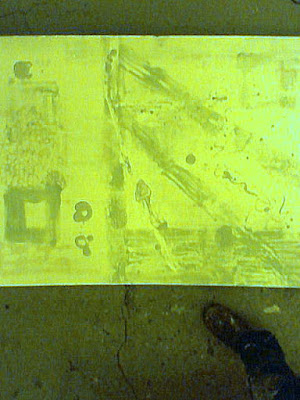My work in the studio this year has mainly involved working and reworking 'damaged' photos, then making litho-transfers of them and working on them again, and repeating the process continually until the image starts to break down and become more mysterious. Or I've been adapting that process for the public art project. I always find myself pulled back to painting, though, despite the fact that I never seem to produce anything that I'm satisfied with. I often do a kind of monoprinting on the surface of the board or canvas, where I place large sheets of newsprint onto the wet surface, and lift them off to drag some of the pigments off and to add new textures. While most of the paintings I've worked on this year are still nowhere near finished or satisfactory, I decided to pull out all these sheets of newsprint, just to see if they would give me some inspiration. Sure enough, these pieces of paper that I had nearly thrown away were in fact better than the paintings that I was dabbing them with. Here are four:
When I was last in the studio, I put some of these out and went back to one of the paintings. Here is a bad cell phone photo (the canvas isn't really bowed), but it gives some idea of what the newsprint blottings might lead to:
Patty often mentions this in relation to her creative writing students: often the work they think is just the throw-away stuff is really their best material. She also tells me that when I show her something from the studio, she doesn't say any more whether she likes it, because she knows it will be completely changed by the next time she sees it.
 Subscribe to Praeterita in a reader
Subscribe to Praeterita in a reader
 |
| Click the image to considerably embiggen it |
Patty often mentions this in relation to her creative writing students: often the work they think is just the throw-away stuff is really their best material. She also tells me that when I show her something from the studio, she doesn't say any more whether she likes it, because she knows it will be completely changed by the next time she sees it.
